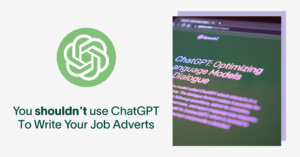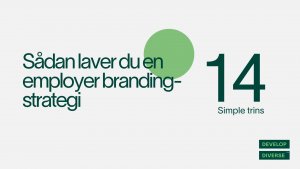Hiring is time-consuming — and time is money. According to 2022 data from SHRM, bringing a new employee onboard and bringing them up to speed can cost between three to four times their salary. Meanwhile, a lengthy time-to-hire can add an even greater cost burden, because when a role sits open, it means your team has to cover the shortfall for longer.
Strategies to reduce time-to-hire and cost-per-hire depend on your organisation’s individual recruitment goals. But knowing how to do this and build an inclusive talent acquisition process? That’s the tricky part.
In this post, DEI consultant Jessica Bantom outlines why organisations struggle to get this balance right, and offers some practical strategies on how to reduce your talent acquisition costs while building a diverse and inclusive organisation.
Why organisations struggle to balance inclusion with talent acquisition
Time-to-hire and cost-per-hire are two key recruiting metrics often used to measure the success of a hiring process. They’re a quantifiable way of evaluating how efficient your hiring process is, and provide a useful benchmark by which you can measure your efforts:
- Cost-per-hire: The total cost of hiring a new employee, including sourcing and recruitment costs, advertising, time spent interviewing candidates, and onboarding.
- Time-to-hire: The total time it takes to hire an employee for a role from sourcing to signing the contract.
Keeping both of these metrics on the lower end is essential for building a more efficient and lean hiring process that doesn’t blow the budget. But often, talent acquisition teams don’t connect these costs back to their DEI strategy when building an inclusive recruitment process.
And that’s part of the problem, says Jessica.
“[Time-to-hire and cost-per-hire] may increase because intentional efforts need to be made to reach a more diverse talent pool, which may require assigning resources to investigate new sources and post job reqs on new platforms,” Jessica says. “These are necessary steps in the process of fostering a presence in new spaces to demonstrate a genuine investment and build relationships to connect with candidates of diverse backgrounds.”
5 strategies to reduce time-to-hire and cost-per-hire that prioritise inclusion
Talent and DEI are often seen as two opposing forces. But the good news is that when you intentionally build an inclusive recruiting process, you can still reduce the time and cost of hiring without compromising on your DEI goals.
Here are five strategies you can implement that will both help foster more inclusive hiring practices, but also reduce time-to-hire and cost-per-hire.
1. Create more inclusive job adverts.
Your job advert could be saying a lot about you — even unintentionally. When the language you use is non-inclusive, it’s likely to be a signal to marginalised candidates that your organisation isn’t a safe space for them.
Implementing inclusive communication software (like us!) can help organisations access a wider and more diverse talent pool, faster — meaning that time-to-hire and cost-per-hire fall. This is because communicating more inclusively doesn’t just positively impact marginalised candidates — it impacts everyone. In our own research, we found that if just 0.6% of the language in a job advert is biased, it negatively impacts a candidate’s likelihood of applying.
When your job advert language is more inclusive, it means you’re more likely to attract more qualified, diverse candidates, which reduces both time-to-hire and cost-per-hire. Instead of trying to hit a diversity quote per role, you naturally widen your talent pool by communicating that your organisation is a place where candidates from different groups can thrive.
“As an organisation, you are targeting people of certain identities,” Jessica says. “Own it. Lean into it. And most importantly, acknowledge it. Articulate that you are intentionally strategising to reach people of different backgrounds and share your ‘why.’ And understand that if this is a new stance for you, it may take new sources you tap into a while to establish that you’re sincere and that you have good intentions to create meaningful professional opportunities for the people in their group.”
2. Focus on creating inclusive employer branding.
Candidate perception of your brand has a lot to do with why people apply to your organisation — and what kind of people apply.
Take our customer Maersk Tankers, for example. After doing an employer branding audit, they realised their careers website wasn’t very inclusive, because it featured a workforce predominantly made up of men — not to mention a lot of pictures of tankers. They quickly realised that they wanted to create a more inclusive perception of their employer brand and encourage more women to apply.
Creating a more inclusive employer brand isn’t an overnight process — but it can help improve time-to-hire and cost-per-hire, because it naturally draws in a wider talent pool.
“Employer branding is key,” says Jessica. “Once again, organisations have to consider the time and resources it takes to develop a brand people trust and believe [in]. There has to be deliberate effort put toward identifying what will genuinely resonate with people of underrepresented groups.
“That requires communicating directly with those populations to find out what’s important to them and what will signal to them that your organisation is in this — and for the right reasons. Historically excluded people can pick up instantly on messaging and branding that was developed for us without us. And the second that happens, you’ve lost your audience.”
3. Be transparent on compensation and pay.
Pay transparency is no longer a nice-to-have — it’s becoming a must-have. Under recent new EU-wide laws, including the Pay Transparency Directive, organisations must report on their gender pay gap at a bare minimum, or face sanctions.
But beyond the law, candidates are increasingly requesting greater pay transparency across the whole recruitment process. A 2022 survey by recruitment site Reed found that 78% of candidates won’t apply for a role if it doesn’t advertise the salary.
Being transparent on your organisation’s pay structure and compensation package during the recruitment process helps reduce your time-to-hire and cost-per-hire for two reasons. One, candidates can self-select out of the process if the salary doesn’t match their expectations, meaning less time is wasted on misaligned expectations. And two, displaying your salary range communicates that your organisation is committed to transparency and equity — communicating you’re an inclusive place to work.
4. Train interviewers to lead a structured interview process.
Research has consistently shown that when interviewers lack training, they’re more likely to let bias creep in during a candidate interview:
- A 2016 study found that overconfident interviewers are more likely to fall victim to personal biases, which leads them to take more hiring risks.
- A meta-analysis on job interviews found that candidates are more likely to believe they were evaluated fairly if the interviewer sticks to a structured process.
- Another study on structured interviews found that well-trained interviewers stick to a structured interview process better than untrained ones.
Structured interviews lead to less bias. And making sure everyone follows a structured interview process that eliminates bias and prioritises fairer hiring outcomes requires the right training.
“A structured interview process is critical in terms of establishing a baseline for what all of your interviewers will be looking for and evaluating in interactions with candidates,” Jessica says. “It helps to minimise bias in the interview process if all candidates are being asked the same thing. However, the tricky part comes in when interviewers have to assess the candidates’ responses because that’s when bias rears its ugly head.
“If you ask two candidates the same question and they answer similarly but one candidate went to the same school as you or they look like you, you will likely pay closer attention to that candidate’s response and/or give them more credit for a good answer.”
Few hiring managers receive interviewer training, so building a comprehensive process that includes structured score cards and question templates, mentoring, shadowing, and continuous, in-the-moment learning will help build a more structured process over time.
5. Create an environment for underrepresented talent to succeed.
Ultimately, reducing your cost-per-hire and time-to-hire among underrepresented candidates requires a long-term commitment. It’s not just about your talent acquisition process — it’s a change that impacts your whole organisation.
When your organisation is visibly committed to diversity, equity and inclusion — and has retained the workforce to demonstrate this — it will increase your access to a whole network of future underrepresented talent.
“‘[It’s important to] focus on your existing talent of diverse backgrounds, and [create] an environment that’s conducive to their success,” Jessica advises. “In doing so, you will likely make them your ambassadors and they have the ear of entire networks of future talent who identify like them that you’re not even aware of or connected to.
“For that very reason, I would also recommend establishing a dialogue with your existing talent and asking them for advice on how to connect with their networks,” Jessica adds. “This would be a strategic and inclusive way to utilise your employee resource groups. Be honest and transparent in your ask and realistic with your expectations. You may not immediately get a flood of responses but if you normalise this dialogue and this type of interaction, it could become very effective.”
Hire diverse candidates, faster and more efficiently
Reducing your time-to-hire and cost-per-hire doesn’t need to be at odds with your DEI strategy. When done well, a more inclusive hiring process can actually help you source more underrepresented talent, because it naturally opens you up to a more diverse talent pool.
We can help you get this right. Develop Diverse is a research-backed inclusive communication platform that helps global organisations — including Maersk Tankers — source underrepresented talent more quickly and efficiently with inclusive job adverts. Find out more by booking a demo.





